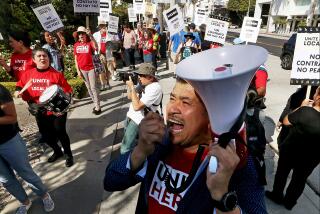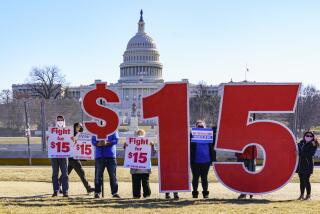San Francisco minimum wage is set to become the highest in U.S.
Thousands of San Francisco workers are starting the new year with a raise.
On Jan. 1 the city’s minimum wage will rise to $10.24 an hour. That’s the highest rate in the country and makes San Francisco the first place in the U.S. to mandate double-digit hourly wages for its lowest-paid workers.
For Ace Wiseman, 27, a recent graduate of San Francisco State University who cleans tables for minimum wage in a Sunset District pizzeria, the raise from $9.92 an hour will buy a few more groceries.
“It’ll be nice.... It all adds up,” he said. “I need a second job to start paying off student loans.”
Many San Francisco employers, however, don’t share Wiseman’s enthusiasm for the higher pay. San Francisco’s rate is well above the California minimum of $8 an hour and federal minimum of $7.25 a hour.
Small businesses, led by the food-crazy town’s No. 1 industry, restaurants, warn that the high rate, combined with other costly city mandates, could force them to lay off workers.
“It makes these jobs so high-paying that they disappear,” said Daniel Scherotter, executive chef and owner of Palio D’Asti, an Italian restaurant in the downtown financial district. “It’s hurting the people it’s trying to help.”
As a result, Scherotter said he cut his kitchen staff by eight people in the last five years and shifted pastry production outside the city limits.
San Francisco’s minimum wage has climbed steadily since voters in 2003 approved a local initiative mandating an annual increase in the minimum wage using a formula tied to inflation. In recent years, the city has also required many employers to provide their workers with health benefits and all employers to offer paid sick time.
Critics have derided the mandates as anti-business job killers. But San Francisco’s economy has proved resilient. The city’s unemployment rate was 7.8% in November, well below the 11.3% statewide rate. Over the last year, the San Francisco metropolitan area, which includes parts of neighboring San Mateo and Marin counties, created 3,900 new jobs, mostly in bars and restaurants within the city of San Francisco, according to the California Employment Development Department.
“San Francisco is a model in terms of showing what can be done to improve labor standards,” said Ken Jacobs, chairman of the UC Berkeley Center for Labor Research and Education. “Extensive economic research on the impact of the [minimum-wage] law found no impact on employment.”
Other academics, though, said it’s difficult to make meaningful conclusions about the effects of minimum wages on the experience of a single city.
“The evidence is pretty overwhelming that these things do cost some jobs, though that doesn’t mean they are a bad idea,” said David Neumark, an economist and the director of the Center for Economics and Public Policy at UC Irvine.
San Francisco isn’t the only government that’s raising the minimum wage next year. Eight U.S. states raised their minimum wages effective Jan. 1. Washington state’s minimum will be the highest, at $9.04 an hour. Nevada will announce its legally required cost-of-living increase in July.
Additionally, scores of local governments around the country, including at least 32 in California, require some private-sector employers to pay so-called living wages. These mandate minimum hourly pay and sometimes benefits for employees of companies that have been awarded city or county contracts or which are in particular regions or industries.
The city of Los Angeles has a 2011 living wage of $10.42 plus health benefits of at least $1.25 an hour for contract workers and employees of hotels along Century Boulevard near Los Angeles International Airport. People working at LAX as well as airports in Ontario and Van Nuys earn at least $10.42 an hour plus health benefits of $4.55 an hour.
In the meantime, no changes are scheduled for the California or the federal minimum wages. California’s minimum wage has not changed since the start of 2008. The federal minimum wage last increased in July 2009.
Although there’s little chance of a deeply divided Congress approving a higher federal minimum wage, an effort is underway in Sacramento to raise the California wage to $8.50 and then peg it annually to the inflation rate.
With the economy still sluggish, California needs the stimulus that would be created by an increase in the minimum wage, said Assemblyman Luis Alejo (D-Watsonville), whose district includes farmworkers in the Salinas Valley.
“At a time when the cost of living is skyrocketing, it’s becoming more difficult for families making the least in the state to keep up with inflation,” he said. “If these low-wage workers get an increase, it goes back into the economy to pay bills.”
Alejo sponsored a minimum-wage bill that’s scheduled for a hearing in the first week of January. A similar bill foundered in the Assembly Appropriations Committee last year with strong opposition from the California Chamber of Commerce, the Western Growers Assn., the California Restaurant Assn. and the California Grocers Assn.
A 50-cent jump in hourly pay translates to a $10,000-a-year increase for a small business with 10 full-time hourly employees earning the minimum wage, the business groups said in a letter to the committee.
Raising the minimum wage this year would be “bad timing,” said Jennifer Barrera, a chamber lobbyist. “With the state of the economy right now, we want to encourage private-sector growth.”
Tying the minimum wage to the inflation rate adds up over time, critics said. When the hike kicks in Jan. 1, San Francisco’s minimum wage will have increased more than 20% since the law was implemented in 2004.
In San Francisco, the bulk of that extra pay is not going to the people who need it the most, said Rob Black, executive director of the Golden Gate Restaurant Assn. He said it’s unfair for waiters, already making $30 to $40 an hour in tips, to get an additional $10.42 an hour from the minimum wage, while kitchen staff get only their regular hourly rate, Black said.
The upshot, he said, is that restaurant owners have to cut corners in the kitchen to come up with the extra money for the front-of-the-house workers.
More to Read
Inside the business of entertainment
The Wide Shot brings you news, analysis and insights on everything from streaming wars to production — and what it all means for the future.
You may occasionally receive promotional content from the Los Angeles Times.











